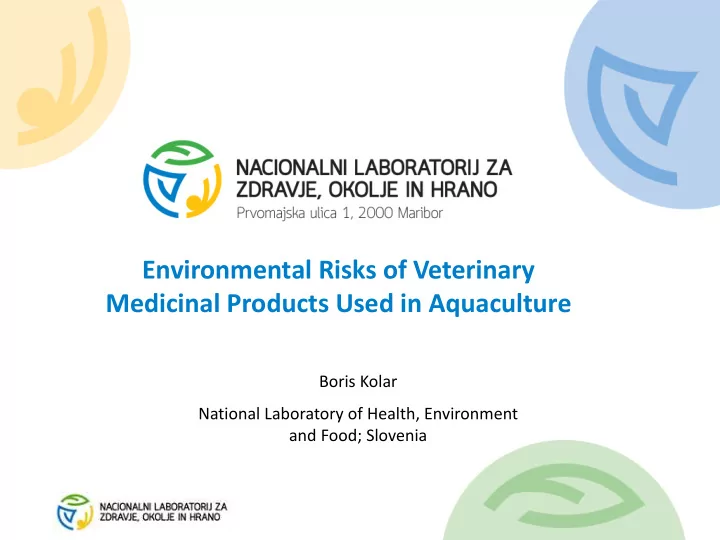

Environmental Risks of Veterinary Medicinal Products Used in Aquaculture Boris Kolar National Laboratory of Health, Environment and Food; Slovenia
Abbreviations and the content of the presntation Abbreviations : Content of the presntation ERA for VMPs and FEEDads ü VMPs – veterinary medicinal products ü ERA for VMPs and FEEDads ü FEEDads- (animal) feed additives ü The Need for VMPs and FEEDads in Aquaculture ü ERA- environmentalk risk assessment ü VMPs in the cold water aquacultures ü PEC - Predicted environmental concentration ü Antimicrobials in aquatic and terrestrial environments ü PNEC- predicted no effect concentration ü Gaps and needs in the assessment of substances used in aquaculture ü RCR-risk characterization ratio (PEC/PNEC) ü RMM risk mitigation measures
ERA for VMPs and FEEDads ; Guidances on ERA for VMPs and FEEDads sets protection goals and standards for environmental safety. ERA: two phase risk assessment, hazard assessment for PBTs Phase I Exclude substances of low suspected environmental risk; no specific data related to substances are required; PEC initial VMPs for aquatic species : An ecto- and/or endoparasiticide; YES→ Phase II PEC for VMP released from aquaculture facilities: ≥ 1 µg/L ; YES → Phase II FEEDads for aquatic species: PEC in surface water ≥ 0.1µg L-1; YES → Phase II The PEC in sediment ≥ 10 µg kg-1; YES → Phase II) In parallel: hazard assessment the PBT is provided in case of identification of the potential PBT (vPvB) substances.
ERA for VMPs and FEEDads ; Pahase II PECr efined , PNEC, PNEC refined , RCR PEC recalculation base on emission scenarios and exposure models; PNEC is extrapolated from the ecotoxicological data and applying uncertainty factor RCR: (PEC /PNEC)→numerical result When: RCR<1 risk is acceptable RCR≥ 1 risk is unacceptable →RMM ; risk-benefit analysis; proposal of ban of the product (VMPs only) BUT: simple (Phase I) and robust, complex models (Phase II) for calculation PEC are not available
Biologicaly active chemicals in Aquaculture VMPs Prevention – General husbandry management (biocides,anesthetics, hormones, desinfectants), – Vaccines, – Biological control: sea lice cleaner fish ( also need a health management), Disease treatment – Therapeutics (antibiotics, antiparasitics, desinfectants), FEEDads – Immunostimulants, probiotics, minerals, metals,
Emission pathway of pharmaceutical from a marine fish farm Addopted from Rigos ,2003
Substances of the environmental concern used in aquaculture VMPs Antibiotics: antimicrobial resistence Acute and long term toxcicity for certain taxonomic groups Antiparasitics: Persistence Bioaccumulation Toxicity for poulations and taxonomic groups PBT, vPvB FEEDads Metals (copper, zinc), accumulation, toxicity, antimicrobial resistance Metaloids (selenium), accumulation, toxicity
List of currently approved VMPs for use in aquaculture in EU Antibiotics Antiparasitic s Antifungals Other • Bronopol • Hydrogen • Azamethiphos Florfenicol • peroxide Teflubenzuron • Oxyetracycline • Formaldehyde • Diflubenzuron • Chlortetracycline • • Emamectin benzoate Amoxicillin • Deltamethrin • Flumequine • • Cypermethrin Sulfadiazine-trimethoprim • Oxolinic acid • MRL application FEEDads Lufenuron Metals (copper, zinc), Hexflumuron Metaloids (selenium), (substances suspected PBT or vPvB)
Challenges : VMPs in the cold water aquacultures (a.e. Atlantic salmon) Medication against sea lice is one of the most important medical treatments in aquaculture: Sea lice is ectoparasitic arthropod; life-stages as zooplankton . Challenges : huge demand in extensive aquaculture production, narrow alternative on the pharmaceutical market VS environmental impact, shellfish, lobster production.
Challenges : VMPs in the cold water aquacultures (Atlantic salmon) Environmental concerns: Some VMPs are suspected to have PBT (Bioaccumulative Persistent, Toxic) intrinsic properties. Potential for bioaccumulation and biomagnifications along the food chain → exposure concentrations cannot be determined Extreme toxicity of antiparasitics, benthic crustacean species such as crabs and lobsters might also be at risk. Risk of impact on the change in structure of zooplankton grazing populations → the outburst of phytoplankton, → lack of food for yung fish. Possible solutions: Other aquaculture practices, a.e introduction of cleaner fish in to cages. Development of new VMPs that pose acceptable environmental risks.
UK Environmental Quality Standards (EQS) antiparasitic Emamectin benzoat Log Kow 5(lypophilic subbstance) Anaerobic aquatic degradation DT50 of 427 days Azamethiphos Log Kow 1.05 Deltamethrin (lypophilic substance) Log Kow 4.6 Adopted from K.H. Langford, 2014
Challenges : antimicrobials in aquatic and terrestrial environments Antimicrobials used in human and veterinary medicine enters the aquatic and terrestrial environment. 80% of antimicrobials used in aquaculture enter the environment with their activity intact. Several of the antimicrobials are not biodegradable under environmental conditions. Environmental concerns: Due to ecotoxicity: Antimicrobials are (very) toxic to phytoplankton and cyanobacteria. Potential effects on the structure → consequently the effect on the function of the ecosystem. Antimicrobials are toxic to terrestrial plants → effect to the grassland plant communities.
Challenges : antimicrobials in aquatic and terrestrial environments Environmental concerns: Development of antimicrobial resistance (AMR) The presence of antimicrobials in the gut of humans and animals leads to the selection of resistant bacteria and resistance genes that are excreted in faeces and may end up in wastewater, sludge, manure and soil. The resistance genes from the environmental reservoir can potentially be transferred to pathogene bacteria. Is the transfer from environmental borne resistant gene to clinical resistance gene relevant. How to assess and mitigate risks?
Gaps and needs in the assessment of substances used in aquaculture Aquaculture emission scenarios VMPs : no specific emission scenario for the inland, freshwater aquaculture or marine aquaculture FEEDads : inland freshwater - raceway ponds, marine aquaculture - fish cages, Emission scenarios and models are not substance specific, as such not useful. EMA, EFSA, REACH: A need for harmonized system for evaluation of substances, A need for basic, robust models for PEC calculation, A need for advanced models for PEC refinement, An urgent need for collaboration between scientific research and regulators
Disclaimer : “I attend this conference as an individual expert, and do not represent the CVMP, ERAWP or EMA. The views expressed here are my personal views, and may not be understood or quoted as being made on behalf of the CVMP, ERAWP or EMA or reflecting the position of the CVMP, ERAWP or EMA.”
Thank you for your attention
Recommend
More recommend